Abstract
Walking is one of the most crucial activities of humans. It is very important for their everyday life, working, shopping, going to jobs, for their well-being and also for communications with friends, relatives, social contacts, and similar. Of course, when the body changes the way people are walking changes too. This is something everybody anticipates to be true and believes to be true. The question is can we quantify this and how much actually changes with age in the way we do walking? This is the main issue we try to elucidate in our article. To do that we consider two groups aged 18-25 and aged 30-40 and analyse what are the basic changes during walking. We do that by creating a biomechanical model of the human body and its computer implementations within a CAD system. The model enables computer simulation and computer design for anthropomorphic robotic applications as well as for medical applications (orthopaedics, traumatology, orthotics, and prosthetics design), among other things.
1. Introduction
According to some sources, research on human motion began around 1000 B.C. An intriguing historical perspective on these investigations in their early stages is contained in [1]. Furthermore, an interested reader can see the text in [2-3]. Among all conceivable factors investigated, the problem of human gait receives particular focus from multiple perspectives. For instance, one can research topics such as neuromuscular disorders, prosthetic joint replacement, various athletic injury-related issues, amputees, orthotics, assistive devices, and sports. In addition, interest in creating humanoid and wearable robots has gradually grown in recent years [4]. In general, it is crucial to understand the physical characteristics of the human body, such as the geometry, mass, and inertial parameters of segments.
In this article, we study the age changes of the mass-inertial characteristics of Bulgarian women aged 18-25 years versus those aged 30-40 years during walking. We are not aware of any other study that confronts the change in the mass-inertial characteristic of the human body of the two groups happening during the walking cycle. According to the literature, the human gait cycle has eight distinct phases which we take into account in the process of modelling the human body.
We start with a geometric mathematical model of the Bulgarian woman that reflects her mass and geometric characteristics. There are 16 segments in the model. Then, we generate this model within 3D CAD software that allows for simulations of walking in each of the eight phases.
2. Description of the model
We utilize mathematical models of the human body of the average Bulgarian woman aged 18-25 years and as well as that woman aged 30-40 years during walking. These models are already described exhaustively in [5, 6]. We thus direct the reader to [5, 6] to avoid repeating the points we made there. The mass inertial parameters of the body segments have been calculated using these models. Here, we employ the model to assess these parameters across the entire body of the average Bulgarian woman. Here, we’ll only make a few quick remarks to highlight the salient details of the study's models, as shown in Fig. 1. This model scheme applies to both age groups.
Fig. 116-segmental model of the human body
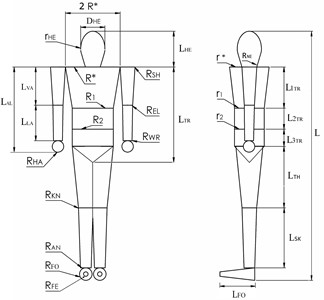
As the figure shows, we decompose the body into 16 segments: head + neck, the upper part of the torso, the middle part of the torso, the lower part of the torso, upper arm, forearm, hand, thigh, shank and foot. In terms of the sagittal plane, we accept complete “left-right” symmetry or full body symmetry. According to the anthropometric points made by [7], the human body is decomposed. To take advantage of analytical expressions for some characteristics, which are then used for the verification of the results obtained within CAD systems, all the elements are supposed to be modelled by relatively simple geometrical bodies.
The collected data for women between the ages of 18 and 25 comes from our own anthropometric measurements of the weight and mass of 36 Bulgarian women, while that for women between the ages of 30-40 are taken from an anthropological survey of 2855 women [8].
From the available data, we construct an average Bulgarian “female aged 18 to 25” having a total mass of M = 54.3 kg and a height of L = 165 cm, whereas an average Bulgarian "female aged 30 to 40" has a mass of M = 65.3 kg and a height of L = 158 cm, respectively.
Let's note that [8] contains an unusually large number of people studied as a whole. We, however, shall mention two other basic studies of mass-inertial characteristics of women in Refs. [7] and [9]: the group of women examined in [7] includes only 15 female athletes, whereas, in another significant study in [9], there are 25 German and 25 Chinese women involved. Thus, our group of 36 women from the town of Sofia appear small, but it is larger than in the other reputable studies mentioned above.
The characteristics of the total body can be studied after the mass-inertial parameters of the segments have been established, positioning the body in each posture of interest. In order to achieve this objective, we realized the model in the CAD system SolidWorks.
3. Results for the model's mass-inertial characteristics during walking
Human motion analysis is now frequently used in both clinical and academic settings. Beyond the broad categories of ambulatory models, the art and knowledge of motion analysis extend to front-line clinical roles in medicine (rehabilitation surgery, prosthesis, and orthoses), ergonomics, and athletics. For the clinician or researcher, the combination of methodical clinical estimation and motion analysis can be a powerful mechanism [1]. Recent advancements in technology have made it possible to analyze human gait using a variety of methods, such as image processing, force platforms and pressure measurement systems – floor sensors, electromyography, etc.
The phases of the gait cycle during walking are categorized in a wide variety of ways. The gait is typically thought of as a continuous series of periodic activities. The full gait cycle is typically defined as the time interval between the first heel strike contact of one foot (for example, the right foot) and the subsequent heel strike contact of the same foot.
Table 1 provides the hip, knee, and ankle joint angles for each of the eight phases of the human gait cycle that were used in our paper.
Fig. 2The human gait is usually considered a cycle decomposed into eight phases

Table 1Joint angles in the gait cycle
Gait phases of human gait cycle | Initial contact | Loading response | Mid stance | Terminal stance | Pre Swing | Initial Swing | Mid Swing | Terminal Swing |
Hip | 20° | 20° | 0° | –20° | –10° | 15° | 25° | 20° |
Knee | 0°-5° | 20° | 0°-5° | 0°-5° | 40° | 60°-70° | 25° | 0°-5° |
Ankle joint | 0° | 5°-10° | 5° | 10° | 15° | 5° | 0° | 0° |
Fig. 33D CAD body model in SolidWorks medium in: a) phase 1 – initial contact; b) phase 3 = loading response; c) phase 5-Pre swing and d) phase 6 – the initial swing of the human gait cycle
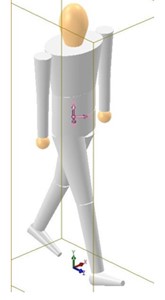
a)
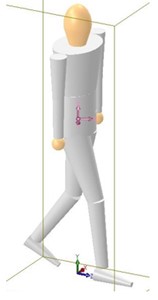
b)
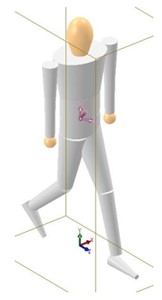
c)
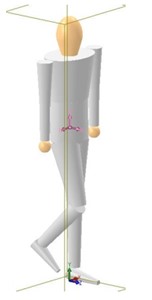
d)
In our work, we use the so-called new gait terms involving the following eight phases, following one of the widely-accepted categorizations reported in the literature: 1) initial contact, 2) loading response, 3) midstance, 4) terminal stance, 5) pre swing, 6) initial swing, 7) mid swing, and 8) late swing are all shown in Figure 2.
Fig. 3 depicts four of the eight phases of the human gait cycle using CAD geometric representations of the body position.
The changing of the spacial position of the centre of mass during walking is one of the parameters that reflect the movement of the entire body. Undoubtedly, determining walking parameters, designing artificial joints, and other practical uses all require an understanding of the three-dimensional movements of the body’s centre of mass.
Fig. 4 illustrates how the centre of mass, which is situated around the pelvic centre, moves in a sinusoidal manner during walking, rising and falling about 2.5 cm in the vertical direction. The findings regarding the vertical displacement of the centre of mass reported in [7] and [10] are very similar to our results.
Fig. 4Displacement of the centre of mass of the body during walking along the vertical axis in [cm]. Obviously, the two curves are almost parallel to each other. The last means that the centre of mass performs a sinusoidal type movement about some average position, approximately given by the coordinates of the centre of mass in a standing position
![Displacement of the centre of mass of the body during walking along the vertical axis in [cm]. Obviously, the two curves are almost parallel to each other. The last means that the centre of mass performs a sinusoidal type movement about some average position, approximately given by the coordinates of the centre of mass in a standing position](https://static-01.extrica.com/articles/23579/23579-img7.jpg)
Fig. 5Comparison of the principal moments of inertia IX≡IXX of average Bulgarian “women aged 18-25 years” and average Bulgarian “women aged 30-40 years” during a single gait cycle
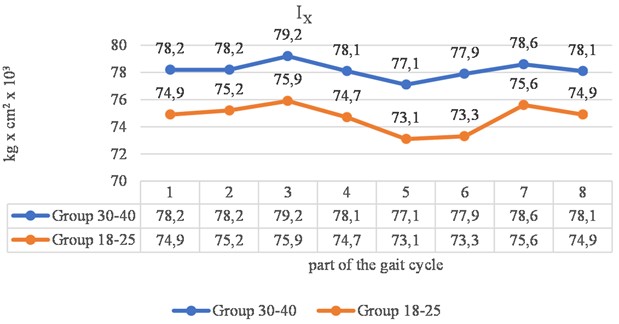
Fig. 6Comparison of the principal moments of inertia IY≡IYY of average Bulgarian “women aged 18-25 years” and average Bulgarian “women aged 30-40 years” during a single gait cycle
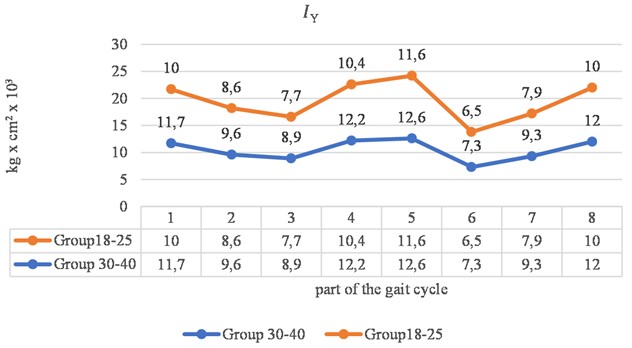
Figs. 5, 6 and 7 contain data for the principal moments of inertia IX≡IXX,IY≡IYY and IZ≡IZZ in units of [kg.cm2×103] of the body in each of the eight phases of a gait cycle for both groups. Inspect the results for the two studied groups we observe that IX for the 18-25 group is larger by 4 % than those of the 30-40 group, while for IY this difference is of the order of 20 %. This is a substantial difference. The obvious reason for the observed difference is that the women in the younger group are taller and thinner. It shall be noted that the distribution of mass along the vertical axis leads to the fact that IZ≡IZZ for the younger women is with higher values than the corresponding ones for the 30-40 group. This property remains valid for all parts of the gait cycle. This difference, however, remains small – of the order of 2-3 %.
Fig. 7Comparison of the principal moments of inertia IZ=IZZ of average Bulgarian “women aged 18-25 years” and average Bulgarian “women aged 30-40 years” during a single gait cycle
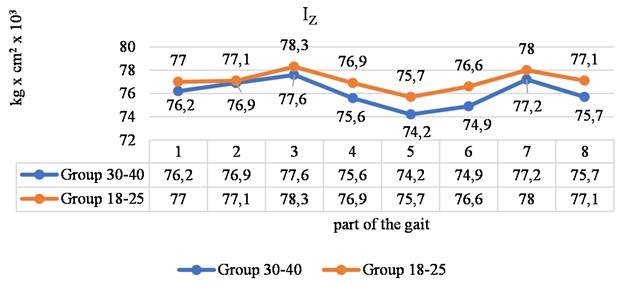
4. Conclusions
Walking, a seemingly simple but fundamental activity plays a significant role in our lives. Beyond its physical benefits, walking has a profound impact on our overall well-being, especially as we age. As individuals progress through different stages of life, changes occur in their bodies, minds, and overall health. The present work explores the age-related changes that occur through the walking of the mass-inertial characteristics of Bulgarian women aged 18-25 years versus those aged 30-40 years in a gait cycle model. Let's take note of the fact that there are not many such studies of women in the literature. Specifically, in the current article, it is investigated how the body’s centre of mass and the principal moments of inertia change during walking. The gait cycle of walking is divided, as it is usually accepted in the literature, into 8 phases.
Usually, the position of the centre of mass of the body is determined within a kinematic model of the body in which the mass of the segments is positioned at the centre of mass of the corresponding segment. The actual shape of the corresponding segment and the mass distribution, however, i.e., what determines the inertial moments, are neglected. Here we addressed these issues by modelling the segments with figures in which the mass density is taken from the experiment.
Let us note that our approach is applicable not only to the “average woman” of a given age group but also to any specific individual provided some basic anthropometric measurements for that individual are performed. For disabled people who require exoskeletons or orthopaedic and prosthetic devices for rehabilitation, we suppose that our study may be helpful.
References
-
G. F. Harris and P. A. Smith, Human Motion Analysis: Current Applications and Future Directions. New York: IEEE Press Text, 1996.
-
W. Braune and O. Fischer, The Human Gait. Berlin, Heidelberg: Springer-Verlag, 1987.
-
D. Winter, The Biomechanics and Motor Control of Human Gait: Normal, Elderly and Pathological. Canada: Waterloo Biomechanics Waterloo, 1991.
-
A. T. Asbeck, S. M. M. de Rossi, I. Galiana, Y. Ding, and C. J. Walsh, “Stronger, smarter, softer: next-generation wearable robots,” IEEE Robotics and Automation Magazine, Vol. 21, No. 4, pp. 22–33, Dec. 2014, https://doi.org/10.1109/mra.2014.2360283
-
G. S. Nikolova and Y. E. Toshev, “Estimation of male and female body segment parameters of the Bulgarian population using a 16-segmental mathematical model,” Journal of Biomechanics, Vol. 40, No. 16, pp. 3700–3707, Jan. 2007, https://doi.org/10.1016/j.jbiomech.2007.06.016
-
G. S. Nikolova, D. M. Dantchev, M. S. Tsveov, and V. K. Kotev, “Mathematical and computer modelling of age changes of basic anthropometric and mass-inertial characteristics of Bulgarian females,” in 15th Conference of the Euro-American Consortium for Promoting the Application of Mathematics in Technical and Natural Sciences, 2023.
-
V. M. Zatsiorsky, Kinetics of human motion. IL: Human Kinetics, Champaign, 2002.
-
Y. Yordanov, A. Nacheva, S. Tornjova, N. Kondova, B. Dimitrova, and D. Topalova, Anthropology of the Bulgarian population at the end of the 20-th century (30-40 years old persons). Sofia, Bulgaria: Prof. Marin Drinov Academic Publishing House, 2006.
-
G. Shan and C. Bohn, “Anthropometrical data and coefficients of regression related to gender and race,” Applied Ergonomics, Vol. 34, No. 4, pp. 327–337, Jul. 2003, https://doi.org/10.1016/s0003-6870(03)00040-1
-
M. S. Orendurff, A. D. Segal, G. K. Klute, J. S. Berge, E. S. Rohr, and N. J. Kadel, “The effect of walking speed on center of mass displacement,” The Journal of Rehabilitation Research and Development, Vol. 41, No. 6, p. 829, 2004, https://doi.org/10.1682/jrrd.2003.10.0150
About this article
This work has been accomplished with the financial support by the Grant No BG05M2OP001-1.002-0011-C02 financed by the Science and Education for Smart Growth Operational Program (2014-2020) and co-financed by the European Union through the European structural and Investment funds.
The datasets generated during and/or analyzed during the current study are available from the corresponding author on reasonable request.
The authors declare that they have no conflict of interest.
